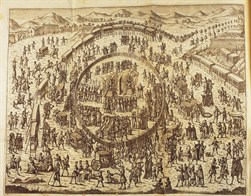The functions of the tribunal of the Inquisition and its introduction in Sicily
 The Inquisition is a decisive element for the characterization of the Baroque atmosphere in Spain and Spanish Italy. As it is known, the tribunal of the Inquisition is an institution commissioned at the end of the fourteenth century to prosecute crimes of heresy. When, partly because of a serious economic crisis aggravated by the presence, for the first time in centuries, of the plague, pauperistic heresies were spreading, the Church promoted an action of reconquest of the faithful. The Order of Friars Preachers, called Dominicans by the name of the founder Dominic de Guzmán, on the one hand spread Christian values ??with an extensive preaching activity in Europe, on the other hand judged severely the guilty of heresy – Patari, Cathars, Waldenses, Fraticelli .. . – in the sessions of the tribunal strongly backed by the popes of the time and placed under the authority of the bishops. During much of the fifteenth century, the tribunal no longer operated: there were not, in fact, the conditions that favoured ideas considered heretical by the Church of Rome.
The Inquisition is a decisive element for the characterization of the Baroque atmosphere in Spain and Spanish Italy. As it is known, the tribunal of the Inquisition is an institution commissioned at the end of the fourteenth century to prosecute crimes of heresy. When, partly because of a serious economic crisis aggravated by the presence, for the first time in centuries, of the plague, pauperistic heresies were spreading, the Church promoted an action of reconquest of the faithful. The Order of Friars Preachers, called Dominicans by the name of the founder Dominic de Guzmán, on the one hand spread Christian values ??with an extensive preaching activity in Europe, on the other hand judged severely the guilty of heresy – Patari, Cathars, Waldenses, Fraticelli .. . – in the sessions of the tribunal strongly backed by the popes of the time and placed under the authority of the bishops. During much of the fifteenth century, the tribunal no longer operated: there were not, in fact, the conditions that favoured ideas considered heretical by the Church of Rome.
With the bull Exigit sincerae devotionis affectus, issued on 1 November 1478, Sixtus IV gave Isabella of Castile and Ferdinand of Aragon the authority to introduce in their territories the permanent tribunal of the Holy Office of the Supreme Inquisition. The two kings, with a strict military action, were recapturing the Iberian Peninsula, up to that time in Muslim hands. The papal concession marked the birth of one of the essential pillars of the exercise of sovereignty within the fragmented monarchy for both Ferdinand of Aragon and Isabella of Castile and for their successors, who could also count on an ideological weapon to cement their composite monarchy. According to what was held by the Pope, not the ecclesiastical authorities but the monarchs had to decide the appointment and dismissal of the officials of the new judicial body competent in matters of orthodoxy of the Christian faith. The rulers then nominated the greatest exponent of the new institution, the General Inquisitor, who had to respond only to them and coordinate all the inquisitors in the various provinces. The result was an organization of top-down type, operating in different Spanish dominions, which acted independently of the constraints that could be raised against the other institutions, because – through the inquisitor general – it responded directly to the sovereign.
